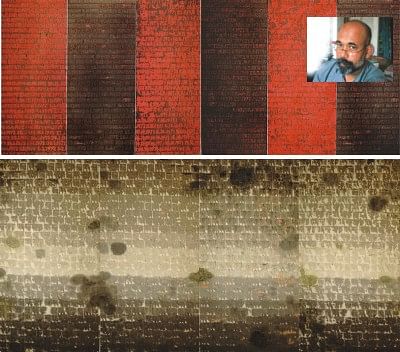Exhibition
Wakil's "journey through life"
Fayza Haq
Wakilur Rahman, based in Berlin, in his exhibition, held at Alliance Francaise on December 3, explains his repeated preoccupation with space. There is a new and fresh element in his latest display, titled In Reading space seeing space, which sets it apart from the earlier exhibition held at Chitrak in 2003, and the one at Goethe Institute in 2001. In the last 10 years, Wakil believes there have been a lot of changes in the world. He too has undergone changes and achieved something in the passage of time. He says that his experiences and exposure have been varied; his friends have seen changes too. In this manner his vision and painting prowess are now more developed. He showed in Chitrak four paintings, and used the space and the architectural backdrop: it was a dialogue between his paintings and their backdrop. "When I go to different places to present my work, I react differently. The galleries, viewers and lighting as well as my thoughts have seen a sea of change. I work with space as I'm only too aware of what I'm doing in the studio which is one type of space; when I bring my work to a gallery, another space is created. My life, so far, has been a continuation of galleries along with my life at different junctures. Every object requires a perfect space to communicate or express itself. I'm in quest of a perfect space for my work. Thus there is a dialogue: when I go to a certain room I react and try to change the room to a desired effect. There is an exchange of views and ideas. This time I've worked with literature." Throwing light on his recent exhibit, Wakil says that the alphabets carry two weights, one in words and the other in sound. He finds that abstraction and non-abstraction, that naturally ensue, is the essence of our very existence. When we comprehend a language, he says, the world opens up, and things take a realistic shape. If one does not understand the particular language, one gets only the sound, and the following impact is an abstract one. Wakil travels widely, having studied in Beijing, in the early '80s, and various other countries, as he's based in Berlin. When he arrived in Berlin, at the outset, he did not comprehend the language clearly. The figurative and non-figurative world is contained in shobdo (sound). This is the first and basic concept of my work. There are eight paintings in the Alliance Francaise gallery, the material being Chinese paper, Chinese ink and European paper. There is no framing , while the paintings these ones being a little bigger than the ones last seen at Chitrak -- are directly painted on to the wall. There were some delicate objects placed on the floor, related to the paintings. Wakil has included a number of books on Bangla poetry: it's the essence of poetry that the artiest has tried to reflect in his present work. His present work is symbolic just as were the ones in the space of a decade in Dhaka. Asked to talk about his experiences, including those with teachers, colleagues, connoisseurs and critiques, Wakil says that earlier, when he went from Dhaka, he did not have enough info on China, which he gained at Beijing. He developed his academic skill in China, and at the same time he learnt a lot from Chinese traditional paintings, and their aesthetics. He used two types of calligraphy: one Bangla and the other Latin. Wakilur Rahman, of international repute, says that he always aims at delineating the metaphors of life. The exhibition was inaugurated by the French Ambassador, Jacques-Andre Costilhes.
|

Samples of Wakilur Rahman┐s paintings & Wakilur Rahman(Inset) |